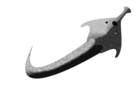昭通鱼属
| 昭通鱼属 化石时期:泥盆纪早期
| |
|---|---|
| 科学分类 | |
| 界: | 动物界 Animalia |
| 门: | 脊索动物门 Chordata |
| 纲: | †盔甲鱼纲 Galeaspida |
| 科: | †昭通鱼科 Zhaotongaspidae |
| 属: | †昭通鱼属 Zhaotongaspis |
| 模式种 | |
| 让氏昭通鱼 Zhaotongaspis janvieri | |
昭通鱼属(学名:Zhaotongaspis),为盔甲鱼纲下的一种鱼类,化石发现于中国云南的坡松冲组[1]。
发现与研究
[编辑]1991年5月,云南昭通市东北地区的泥盆纪地层坡松冲组(布拉格期)发现了许多早期脊椎动物化石,其中鱼类化石的种类包括盔甲鱼类、盾皮鱼类与肉鳍鱼类[1]。
特征
[编辑]昭通鱼有30至40对鳃穴(可能为无颔类生物中鳃的数量最多的种类),中背孔非常大,呈椭圆形;角内缘具有12至20个小刺[1]。
命名
[编辑]昭通鱼的模式种名来自于法国古生物学家 Philippe Janvier 博士[1]。
参考文献
[编辑]
| ||||||||||||||||||||||||||||||||||||||||||||||||||||||||||||||||||||||||||||||||||||||||||||||||||||||||||||||||||||||||||||||||||||||||||||||||||||||||||||||
|
Text is available under the CC BY-SA 4.0 license; additional terms may apply.
Images, videos and audio are available under their respective licenses.




